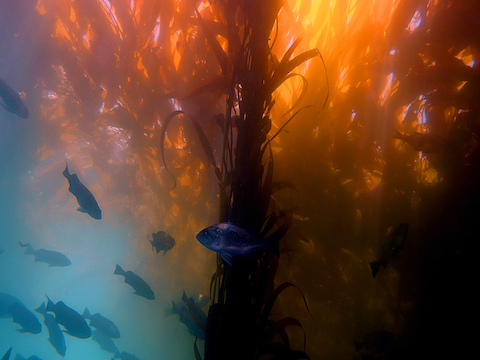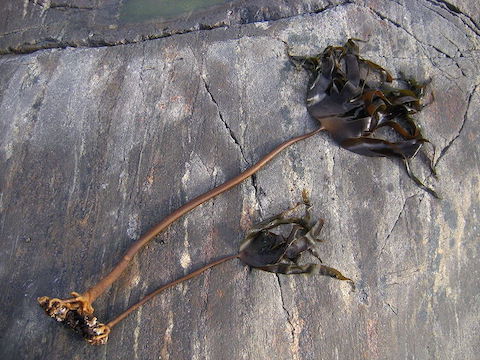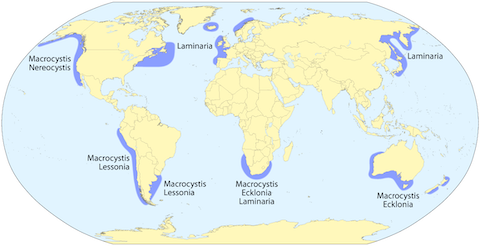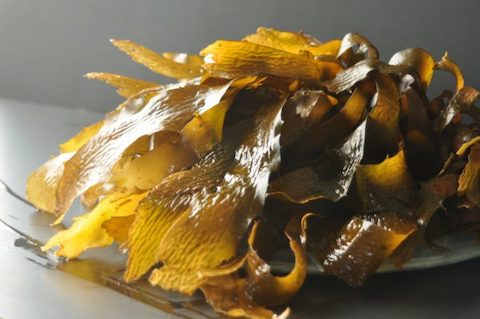
It might surprise you to hear that there are forests underwater.
In temperate oceans near the shore, kelp grows. It’s technically not a plant, but algae–specifically, a brown macroalgae.
And macro it is. The largest species of kelp can reach 130 feet.
They stretch from the dark ocean floor, where they anchor to rocks. A long stem grows upward to where the kelp can reach light. There, it produces long leaf-life blades that conduct photosynthesis.
The stalk and fronds are held upright by gas-filled buoys that the kelp produces, called pneumatocysts.
Kelp are extraordinary growers, able to leap nearly 2 feet in a single day. As they grow, they take in carbon dioxide, nitrogen, and phosphorus from seawater, de-acidifying it, and they return oxygen, enriching their environment for other lifeforms.
And like terrestrial forests, kelp shelters great biodiversity: fish, shellfish and other invertebrates, and mammals like sea otters and sea lions.
Kelp is often harvested for algin, a gel-like substance used as a thickener in cosmetics, shampoos, toothpastes, and foods like pudding and ice cream.
On top of that, kelp is nutritious, rich in potassium, iron, and other minerals and vitamins. It’s already a staple in many Asian cuisines and is gaining popularity in others.
These qualities make kelp and other large seaweeds ideal candidates for ocean farming, which we’ll talk about in another EarthDate.
Background
Synopsis: Wildfire decimates forests across the planet each year, but there is one type of forest that is fireproof, submerged in Earth’s oceans. Fast-growing kelp forests are efficient carbon sinks that don’t require fertilizer or freshwater and have a lot to offer.
- Kelp forests look like oceanic jungles, but kelp isn’t a plant: it is a type of seaweed.
- Seaweeds include a broad range of range of marine organisms, including red algae (Rhodophyta), green algae (Chlorophyta), and brown algae (Phaeophyta), as well as plants like marine grasses.
- Kelp is brown macroalgae of the order Laminariales, which includes 31 different genera.
- Brown algae evolved about 100 million years ago. Kelp appeared in the oceans some 20–30 million years ago.
- Sometimes referred to as “tangle,” kelp varieties have long, leathery blades that resemble leaves.
- On the blades of most species, kelp fronds are buoyed by air-filled pneumatocysts that dampen waves and currents at the surface.
- Dependent on light for photosynthesis, kelp grows a long stemlike “stipe” that extends to the photic zone from a seafloor anchor called a “holdfast.” The holdfast anchors kelp to rocks, keeping the beds from floating away from nutrient-rich nearshore waters, but does not provide nutrients like a plant’s root system does.

- Just like terrestrial forests, these dense undersea jungles provide food and shelter for thousands of organisms, including hundreds of species of fish, invertebrates, marine mammals, and birds.
- Fish shelter in the fronds of kelp beds, which serve as a nursery for their young, hiding them from predators and protecting them from the turbulence of waves, especially during storms.
- Invertebrates like brittle stars, sea stars, anemones, and sponges feed on the blades and live around the holdfast.
- The rich kelp forest ecosystem supports seals, sea lions, whales, gulls, terns, egrets, herons, cormorants, and shore birds.
- Sea otters have a special role within the kelp forest: protecting it from overgrazing by their favorite prey, sea urchins. Sea otters keep the urchins in check so they don’t weaken or sever the stemlike stipes, destroying the bed.
- And, just like forests, they are threatened.
- Winter storms can rip kelp beds from the seafloor.
- Damage from entangled boats and coastal pollution also takes its toll.
- Warming seas are forcing kelp forests to shift to higher latitudes, leaving tropical species in their former habitats. This decade, scientists watched as an ocean heat wave wiped out 60 mi (100 km) of western Australian kelp forests, shifting the habitat to higher latitudes.
- Kelp is known for its incredible growth rate. The largest varieties, from the genera Macrocystis and Nereocystis, can grow as fast as 20 inches (50 cm) per day.
- Kelp generally grows in shallow, open ocean waters ranging from 25 to 100 ft (8–30 m) in depth, where nutrient-rich upwelling currents deliver nutrients from the ocean depths. Where water is clear, larger species may grow as tall as 130 ft (40 m).

- Extremely fast growth rates make kelp forests highly efficient carbon sinks that also contribute to the improved health of their ocean communities.
- During photosynthesis, kelp takes in large quantities of carbon dioxide, nitrogen, and phosphorous, de-acidifying seawater as it sequesters carbon.
- As a product of photosynthesis, kelp releases oxygen into the water column, reoxygenating the ecosystem.
- It is hard to imagine that man could improve on nature in this case, but a recent experiment near California’s Catalina Island used kelp “elevators” to lower kelp into deep nutrient-rich currents at night, returning the macroalgae to the photic zone by day. Over 110 days, the elevated kelp grew three times faster and weighed four times more than kelp that was maintained at a constant typical depth.
- Researchers have suggested using large-scale kelp farming to sequester billions of tons of carbon dioxide from the atmosphere, but then what do we do with it?
- One way to lock the carbon away forever would be to isolate it by burial in the deep ocean, but first we would need to work out how to keep it buried permanently.
- Kelp can be processed into biofuel that provides an energy source but doesn’t compete for land with traditional food crops.
- It can be used as agricultural fertilizer and as food on mollusk farms.
- Adding it to livestock feed reduces livestock methane emissions by as much as 70% and provides the animals with higher nutritional value.
- And humans can eat it, too. If cooked with beans, it aids digestion and lowers methane emissions in humans also.
- Kelp has been farmed for centuries as a food crop, especially in Asia, where dried kelp is known as kombu in Japan and haidai in China.
- Kelp doesn’t take up space on land, and it doesn’t need fresh water, fertilizer, or pesticides.
- It is nutritionally dense with plenty of potassium, iron, calcium, iodine, fiber, vitamins, and umami.
- Fresh kelp has a crisp, snappy texture like al dente pasta and a salty-savory oceanic taste similar to oyster liquor. It is usually enjoyed as noodles and in soups, salads, breads, cakes, and cookies, or as a savory cooking seasoning.
- Kelp is a source of algin, which is used by the cosmetic and food industries as an emulsifying agent, so you might find it in your cosmetics, toothpaste, shampoo, salad dressing, puddings, ice cream, and cakes.
- Increasing ranks of ocean farmers are cultivating varieties of shellfish and seaweeds along Atlantic and Pacific coastlines using vertical farms. It’s good news that we will talk about in a future EarthDate episode.


